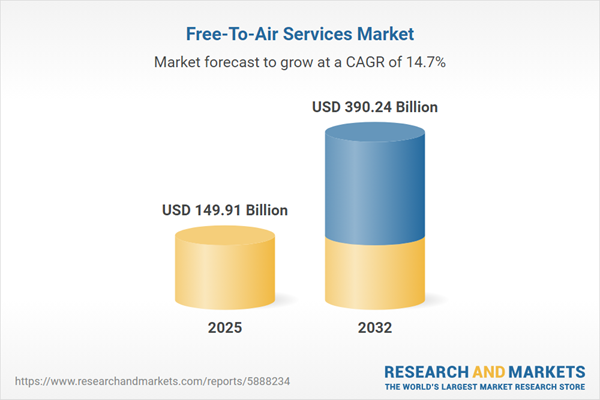Speak directly to the analyst to clarify any post sales queries you may have.
The free-to-air services market is rapidly evolving, shaped by digital innovation, diverse audience preferences, and the adoption of multiplatform content strategies. Senior decision-makers must anticipate ongoing transformation, leveraging technological change and agile business practices to drive sustainable growth and long-term audience engagement.
Market Snapshot: Free-To-Air Services Market Size and Trends
The free-to-air services market is set for robust expansion, with its trajectory bolstered by next-generation global digital infrastructure and improved accessibility to a wider range of programming. Market growth reflects increasing demand for diverse, culture-specific content and greater adoption of advanced broadcast technologies. Providers benefit from the rising consumption of digital and on-demand content, as well as enhanced broadcast capabilities that support engagement across varying demographics and geographies. Multiplatform distribution, combined with linguistic and regional tailoring, enables broadcasters to build resilience and connect effectively with both established and emerging markets.
Scope & Segmentation: Comprehensive Coverage in Free-To-Air Services
This report delivers strategic intelligence and actionable guidance to senior leaders, supporting effective diversification, competitor benchmarking, and timely response to changing viewer expectations. The segmentation assists in data-driven decision-making and unlocks value across high-growth opportunities:
- Content Types: Drama series; film premieres; reality programming; music and business news; major sports such as basketball, cricket, football; local and regional broadcasts customized for deeper audience engagement.
- Transmission Technologies: Satellite services including C Band and Ku Band; analogue and digital terrestrial systems; enabling scalable delivery across different regulatory and infrastructure scenarios.
- Device Types: Smartphones, Android and iOS tablets, desktops, laptops, smart TVs, set-top boxes; supporting market expansion and consistent viewer interaction.
- Revenue Models: Interactive and linear advertising, government support, crowdfunding, direct audience contributions, corporate partnerships, licensing; providing financial flexibility and adaptation to evolving economic settings.
- Applications: Electronic program guides, live event streaming, news distribution, commerce linked to broadcasts, enhanced DVR and NDVR solutions; all aimed at increasing content accessibility and engagement.
- Frequency Bands: Utilization of L Band (L1, L2), UHF, and VHF frequencies; ensuring optimal spectrum use and reliable broadcast service globally.
- Geographic Regions: Coverage of North America, South America, Europe, Middle East, Africa, Asia-Pacific; with focused analysis for the United States, Brazil, UK, UAE, Nigeria, China, India, Australia, and Japan.
- Leading Companies: Market performance insights on ITV plc, Fuji Television Network, Nippon Television Network, TF1 Group, RTL Group, TV Asahi Holdings, Mediaset S.p.A., ProSiebenSat.1 Media, Atresmedia, and Seven West Media.
Key Takeaways: Strategic Insights for Senior Leaders
- Multiplatform distribution is essential for reaching segmented audiences across different regions and cultures, extending both market presence and viewer connection.
- Blending broadband and conventional broadcasting supports advanced personalization, strengthening differentiation within competitive environments and aligning with current viewer habits.
- Active partnerships with technology and equipment vendors improve agility in adapting to changing infrastructure landscapes and diverse regulatory requirements.
- Implementing advanced data analytics in programming and audience outreach enables precise targeting, supporting deeper engagement and better resource allocation.
- Enhancing device interoperability across platforms supports consistent brand recognition and accommodates shifts in consumer viewing patterns.
- Closely tracking policy and regulation updates is vital for managing operational stability and enabling effective realignment in response to sector changes.
Tariff Impact: Adjusting to Shifting Regulations in Broadcasting Equipment
New tariffs set to affect U.S. imports of broadcasting equipment in 2025 are prompting organizations to reassess procurement practices and increase supplier diversification. Companies reliant on satellite hardware and digital tuners are reviewing vendor strategies and cost structures to reduce supply chain risk. Strategic balancing between local and global suppliers has become a priority for maintaining continuity as regulatory changes take effect.
Methodology & Data Sources
Research draws on executive interviews, rigorous regulatory and technical assessments, and leading industry publications. Data is cross-validated, supporting trustworthy projections and comprehensive analysis tailored to the free-to-air services market.
Why This Report Matters
- Empowers leaders to realign strategies and guide digital transformation with up-to-date, well-sourced intelligence on both technology and operational models.
- Supports enhanced content delivery, stronger audience engagement, and risk management amid market and regulatory shifts.
- Facilitates informed decision-making with validated data and relevant insights for identifying sustainable growth opportunities.
Conclusion
This report equips decision-makers with targeted segmentation and in-depth analysis to anticipate sector risks, refine business strategies, and demonstrate agile leadership in a changing media environment.
Additional Product Information:
- Purchase of this report includes 1 year online access with quarterly updates.
- This report can be updated on request. Please contact our Customer Experience team using the Ask a Question widget on our website.
Table of Contents
3. Executive Summary
4. Market Overview
7. Cumulative Impact of Artificial Intelligence 2025
Companies Mentioned
The companies profiled in this Free-To-Air Services market report include:- ITV plc
- Fuji Television Network, Inc.
- Nippon Television Network Corporation
- TF1 Group
- RTL Group
- TV Asahi Holdings Corporation
- Mediaset S.p.A.
- ProSiebenSat.1 Media SE
- Atresmedia Corporación de Medios de Comunicación, S.A.
- Seven West Media Limited
Table Information
| Report Attribute | Details |
|---|---|
| No. of Pages | 192 |
| Published | October 2025 |
| Forecast Period | 2025 - 2032 |
| Estimated Market Value ( USD | $ 149.91 Billion |
| Forecasted Market Value ( USD | $ 390.24 Billion |
| Compound Annual Growth Rate | 14.6% |
| Regions Covered | Global |
| No. of Companies Mentioned | 11 |









